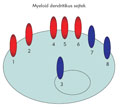The eLitMed.hu medical portal uses computer cookies for convenient operation. Detailed information can be found in the Cookie-policy.
Hungarian Immunology - 2005;4(03-04)
Content
[Plasmacytoid dendritic cells - type I interferon producing cells]
[Dendritic cells represent a multifunctional cell population classified to myeloid (mDC) and plasmacytoid (pDC) types. Both subsets circulate in the peripheral blood and are found in lymphoid and also in non-lymphoid tissues, where they act as sensors of environmental changes. Upon activation by a wide range of stimuli they undergo morphological and functional transition and give rise to professional antigen presenting cells, which migrate to lymphoid organs. A newly identified precursor subset of human dendritic cells has recently been identified as professional type I interferon producing cells (IPC) with multiple functional activities. With their capacity of priming, instructing and regulating various pathogen- and tumor-specific immune responses, IPC/pDC act as a link between innate and adaptive immunity. The role of pDC in the pathogenesis of various diseases is well established, and these cells also emerge as novel candidates of immunomodulation.]
[Transmission of antibodies from mother to offspring: evolutionary aspects]
[The earliest known form of transmission of antibody is the transport from the maternal circulation into the yolk during vitellogenesis (in birds and reptiles), followed by endodermal uptake and transport into the embryonal circulation. During the early mammalian evolution lacteal secretion and the development of the placenta opened new ways to feed the young. These changes also resulted in alterations in sites and mechanisms of transmission of immunoglobulins. In a few species (e.g. rabbit and rodents) the yolk-less yolk sac gained a new function, i.e. the absorption of uterine secretion. In most of the mammalian species the neonatal type Fc-receptor (FcRn) plays a key role in the transmission and confers IgG-selectivity on the process. In ungulates undigested colostral proteins, including antibodies, are absorbed non-selectively by the gut, mediated by sizable transport vacuoles. The limited postnatal transmission period (24 to 48 h) is compensated by the considerable length of the small intestine and the efficiency of absorption. In the human chorioallantoic placenta the two steps of transmission (maternal secretion and absorption by the offspring) were reduced to a single step. Absorption of IgG is often carried out in a proteolytic environment (yolk sac, gut lumen, intestinal vacuoles), and as a result, different mechanisms evolved for the protection of antibody.]
[Regulatory T cells in mixed connective tissue disease]
[INTRODUCTION - CD4+/CD25+high suppressor and IL-10 producing CD4+ regulatory T (IL-10 Treg) cells were investigated in the peripheral blood of 48 patients with mixed connective tissue disease (MCTD). Seventeen patients were in active and 31 patients in inactive state. PATIENTS AND METHODS - Measurement of the number of CD4+CD25+high suppressor and IL-10 Treg cells was carried out by flow cytometry. RESULTS - The absolute number and percent of CD4+CD25+high T cells decreased in MCTD patients compared to the healthy controls. The number of CD4+CD25+high Treg cells was lower in 17 active MCTD patients than in the inactive patients. The percent and absolute number of IL-10 Treg was elevated in the peripheral blood of patients with MCTD compared to the healthy controls. Corticosteroid and immunosuppressive drugs moved the number of regulatory T cells (CD4+CD25+high and IL-10 Treg cells) towards the normal value. CONCLUSIONS - Our results show that the decrease in the number of CD4+CD25+high T cells could play a key role in the immunoregulatory disturbance in MCTD. Elevation in the number of IL-10 Treg cells might be a compensatory mechanism to retain the balance of proinflammatory and anti-inflammatory cytokines.]
[Extensive flow cytometric characterization of plasmocytoid dendritic cell leukemia cells]
[INTRODUCTION - Accumulating evidences suggest that non-T, non-B cell CD4+/CD56+ neoplasms with lymphoblastic morphology include clinically and immunophenotypically diverse entities. Although their cells of origin or classification are still controversial several entities clearly represent a distinct type of neoplasms that are clinically aggressive. CASE REPORT - In this work we present the immunophenotypic and genotypic features of bone marrow, peripheral blood, lymph node and skin lymphocytes from a patient diagnosed as plasmacytoid dendritic cell leukemia involving the skin, bone marrow, peripheral blood, lymph nodes, liver and spleen. For determination of immunophenotypic characteristics of malignant plasmacytoid dendritic cells 73 monoclonal antibodies detecting lineage markers, chemokine receptors, cytokine receptors, activation and co-stimulatory molecules were used. The malignant cells proved to express CD4+, CD56+ lineage negative leukemia phenotype characteristically positive for CD36, CD38, CD40, CD45, CD45RA, CD68, CD123, CD184, HLA-DR, BDCA2 and granzyme-B corresponding to the preplasmacitoid dendritic cell developmental stage. CONCLUSION - The presence of CD11a/CD18, CD84, CD91, CD95, αvβ5, CDw197 and the absence of CD52 and CD133 in this case can be regarded as additional features of malignant cells.]
1.
Clinical Neuroscience
[Headache registry in Szeged: Experiences regarding to migraine patients]2.
Clinical Neuroscience
[The new target population of stroke awareness campaign: Kindergarten students ]3.
Clinical Neuroscience
Is there any difference in mortality rates of atrial fibrillation detected before or after ischemic stroke?4.
Clinical Neuroscience
Factors influencing the level of stigma in Parkinson’s disease in western Turkey5.
Clinical Neuroscience
[The effects of demographic and clinical factors on the severity of poststroke aphasia]1.
2.
Clinical Oncology
[Pancreatic cancer: ESMO Clinical Practice Guideline for diagnosis, treatment and follow-up]3.
Clinical Oncology
[Pharmacovigilance landscape – Lessons from the past and opportunities for future]4.
5.











